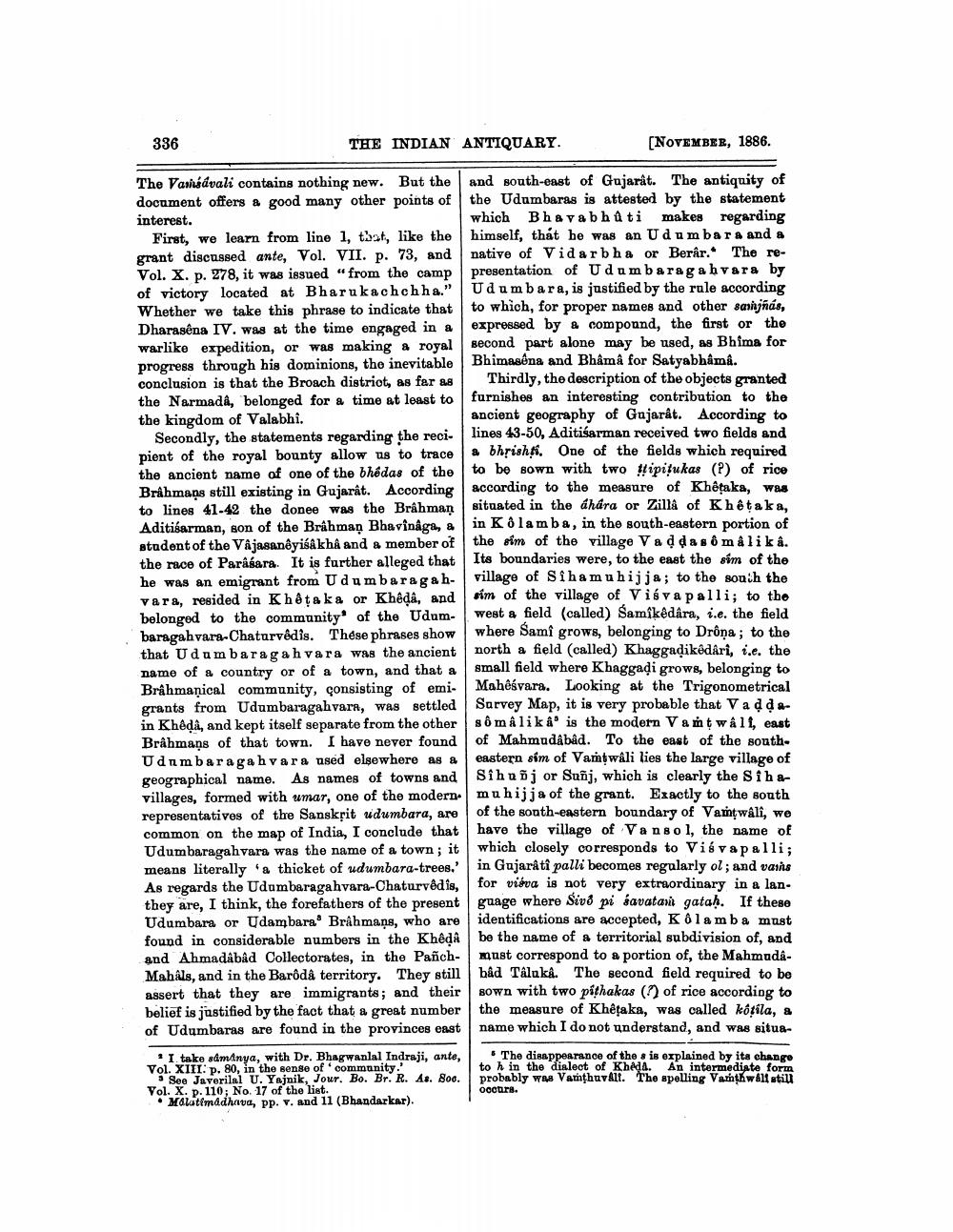________________
336
THE INDIAN ANTIQUARY.
The Vamáávali contains nothing new. But the document offers a good many other points of interest.
First, we learn from line 1, that, like the grant discussed ante, Vol. VII. p. 73, and Vol. X. p. 278, it was issued "from the camp of victory located at Bharukachchha." Whether we take this phrase to indicate that Dharasena IV. was at the time engaged in a warlike expedition, or was making a royal progress through his dominions, the inevitable conclusion is that the Broach district, as far as the Narmada, belonged for a time at least to the kingdom of Valabhi.
Secondly, the statements regarding the recipient of the royal bounty allow us to trace the ancient name of one of the bhedas of the Brahmans still existing in Gujarât. According to lines 41-42 the donee was the Brahman Aditisarman, son of the Brahman Bhavinåga, a student of the Vâjasanêyisakha and a member of the race of Parâsara. It is further alleged that he was an emigrant from Udumbaragahvara, resided in Khêṭaka or Khêdâ, and belonged to the community of the Udumbaragahvara-Chaturvedis. These phrases show that Udumbaragahvara was the ancient name of a country or of a town, and that a Brahmaṇical community, consisting of emigrants from Udumbaragahvara, was settled in Khêdâ, and kept itself separate from the other Brahmans of that town. I have never found Udumbaragahvara used elsewhere as a geographical name. As names of towns and villages, formed with umar, one of the modern representatives of the Sanskrit udumbara, are common on the map of India, I conclude that Udumbaragahvara was the name of a town; it means literally a thicket of udumbara-trees.' As regards the Udumbaragahvara-Chaturvedis, they are, I think, the forefathers of the present Udumbara or Udambara Brahmans, who are found in considerable numbers in the Khêdâ and Ahmadâbâd Collectorates, in the PañchMahals, and in the Barôdâ territory. They still assert that they are immigrants; and their belief is justified by the fact that a great number of Udumbaras are found in the provinces east
[NOVEMBER, 1886.
and south-east of Gujarât. The antiquity of the Udumbaras is attested by the statement which Bhavabhuti makes regarding himself, that he was an Udumbara and a native of Vidarbha or Berâr. The representation of Udumbaragahvara by Udum bara, is justified by the rule according to which, for proper names and other sanjñás, expressed by a compound, the first or the second part alone may be used, as Bhima for Bhimasena and Bhâmâ for Satyabhâmâ.
I take samanya, with Dr. Bhagwanlal Indraji, ante, Vol. XIII. p. 80, in the sense of community."
See Javerilal U. Yajnik, Jour. Bo. Br. R. As. Soc. Vol. X. p. 110; No. 17 of the list.
Malatimadhava, pp. v. and 11 (Bhandarkar).
Thirdly, the description of the objects granted furnishes an interesting contribution to the ancient geography of Gujarât. According to lines 43-50, Aditiśarman received two fields and a bhrisht. One of the fields which required to be sown with two tipitukas (?) of rice according to the measure of Khêṭaka, was situated in the áhára or Zillâ of Khêṭaka, in Kolamba, in the south-eastern portion of the sim of the village Vaddasô mâlika. Its boundaries were, to the east the sim of the village of Sihamuhijja; to the south the sim of the village of Visvapalli; to the west a field (called) Samîkêdâra, i.e. the field where Sami grows, belonging to Drôņa; to the north a field (called) Khaggadikêdâri, i.e. the small field where Khaggadi grows, belonging to Mahêśvara. Looking at the Trigonometrical Survey Map, it is very probable that V a dḍasômâlikâ' is the modern Vam twâll, east of Mahmudâbâd. To the east of the southeastern sim of Vamtwâli lies the large village of Sihu ñj or Suñj, which is clearly the Sihamu hijja of the grant. Exactly to the south of the south-eastern boundary of Vamtwâli, we have the village of Vansol, the name of which closely corresponds to Visvapalli; in Gujaratî palli becomes regularly ol; and vains for viva is not very extraordinary in a language where Sivo pi savatam gataḥ. If these identifications are accepted, Kôlamba must be the name of a territorial subdivision of, and must correspond to a portion of, the Mahmudâbåd Tâlukâ. The second field required to be sown with two pithakas (?) of rice according to the measure of Khêtaka, was called kotila, a name which I do not understand, and was situa
The disappearance of the s is explained by its change to h in the dialect of Khêda. An intermediate form probably was Vamthuvalt. The spelling Vamthwall still
occurs.




